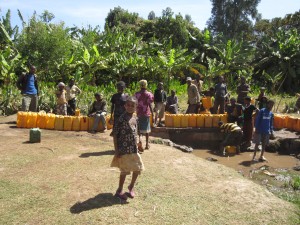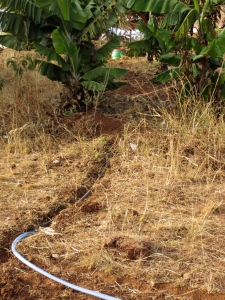(Note: this is a long one, but with some good info. on the water situation here in Soddo)

Yesterday evening we arrived back at our home (and the Children’s Home) here in Soddo, Wolaita, after a few days break away in Addis. This morning I got up to assess the water situation on the compound. It’s now been two weeks since the town electrical sub-station blew up. For the past week, Soddo has had some inconsistent and low-voltage electrical power by re-routing some lines and connecting Soddo to a sub-station further north. Unfortunately, the electrical power has not been sufficient to run the town water dept. water pumps and thus the town water system has remained inoperable for the past two weeks. This has left the whole town relying on donkey water or small hand-pump wells (many of which are dry this time of year, including ours). Because of increased demand for donkey water, prices have doubled and it has become difficult to arrange delivery from a donkey water carrier.
Last week before we left for Addis, because of some special donations to Aerie Africa, we were able to contract with one donkey water carrier to supply the Children’s Home exclusively on a daily basis. We arranged for him to bring 12 – 14 donkeys worth of water to the Children’s Home daily. This is what is required daily to cook, clean, wash clothes, bathe children and for drinking. This morning I learned that our contract was working out reasonably well. The carrier has been able to de liver between 10 – 14 donkeys worth of water to the Children’s Home per day for the last week. The inconsistency is based on how busy the spring is and how long he has to wait in line to fill up his jerry cans. This particular carrier has two donkeys, therefore he has to make between 6 – 7 trips / day just to supply the Children’s Home with water. As I discovered this morning, the walk from the Children’s Home to the spring and back is about one hour round trip, not including wait time at the spring. So, though this has been an additional expense, getting consistent, daily donkey water has allowed the home to function and the children to remain clean (at 15 ETB / donkey, this costs the home about 1,260 ETB or $75 / week).
liver between 10 – 14 donkeys worth of water to the Children’s Home per day for the last week. The inconsistency is based on how busy the spring is and how long he has to wait in line to fill up his jerry cans. This particular carrier has two donkeys, therefore he has to make between 6 – 7 trips / day just to supply the Children’s Home with water. As I discovered this morning, the walk from the Children’s Home to the spring and back is about one hour round trip, not including wait time at the spring. So, though this has been an additional expense, getting consistent, daily donkey water has allowed the home to function and the children to remain clean (at 15 ETB / donkey, this costs the home about 1,260 ETB or $75 / week).
As the first donkeys were arriving this morning with water, I decided to go for a little hike to find the source of the donkey water these days. Prior to the sub-station problem, most donkey water simply came from a town tap in a part of town that had running water that day. Without the town taps, the donkey carriers have been forced to travel outside of town to springs and small streams. So this morning, I grabbed my camera, took along a few friends who are visiting us, and went in search of the nearest spring.
Our hike took us out our compound main gate, down the road heading away from town a few hundred meters, then to the left down a small path that ran along outside the south fence of the Children’s Home compound. This path descended down hill, then to the right and basically continued for about 30 minutes in a westerly direction downhill into the valley west of the town. After about 30 minutes, the path crossed the dirt road that runs towards Jenka in Gamo-Gofa southwest of Soddo. Shortly after crossing this road, the path turned right and opened up into a large flat field area, in which there are lots of people, donkeys and cattle. There were three springs at three edges of this field and some small ditches of water running across the field from the three springs (and apparently a fourth spring a little further beyond the field that we did not go to).
One of springs was really more of a well. It had been hand-dug, cased in cement and capped off. There was a small square opening in the cement cap where people lined up to dip their buckets and jerry cans to fill up with water. Because this well required dipping buckets down into the water, the water was pretty dirty, but there was little to no line to fill up. One donkey water carrier who was filling up as this well told me that he often uses this well because he doesn’t like waiting in the long lines at the other springs for cleaner water. He said he was recently charging 20 ETB / donkey in town for the water from this well, but if customers wanted the cleaner water, he charged more.
was a small square opening in the cement cap where people lined up to dip their buckets and jerry cans to fill up with water. Because this well required dipping buckets down into the water, the water was pretty dirty, but there was little to no line to fill up. One donkey water carrier who was filling up as this well told me that he often uses this well because he doesn’t like waiting in the long lines at the other springs for cleaner water. He said he was recently charging 20 ETB / donkey in town for the water from this well, but if customers wanted the cleaner water, he charged more.
Across the field there was a second spring. At this spring we found a crowd of people trying to fill up their jugs and jerry cans. As we approached, there was a small scrap that broke out between several people as they struggled to get their buckets under the pipe. This spring has been capped with a concrete structure with three pipes running from it. The water running from the pipes seemed pretty clean and the people standing around waiting for water told us that it was good and clean for drinking. The third spring as further across the field again. This spring involved one large pipe flowing out of the side of a concrete structure. At this spring, a few boys seemed to have imposed some organization. People were lining their jerry cans up in one straight line and waiting while the boys filled the jerry cans one at a time in order. When we asked if there was lots of water, everyone said ‘yes’ and that they’d never seen the spring dry. Some of the people were from just nearby and said that they’d always come to this spring for water (they’re far enough out of town that there are no town taps any way). Others in line were from further away or were donkey carriers and said that though there was always lots of decent water at these springs, it was far from town and involved a lot of walking and waiting since the town water system stopped working and more people were coming to these springs for water.

We’ve had a lot of emails from people trying to better understand our water situation here at the Children’s Home. Sometimes it’s difficult to explain exactly the issue that we have here. While currently, because of our reliance on donkey water, water cleanliness is somewhat of a concern, our primary concern is water access. There is plenty of good quality water underground here in Soddo, but because Soddo is on highland terrain, this water is deep underground, somewhere in the range of 150+ meters down. On the outskirts of town, particularly where the terrain slopes down into valleys, there are springs and good wells much closer to the surface. Cleanliness of our water currently is an issue mainly because of the way in which the water is transported – in old, dirty jerry cans on the backs of donkeys – and because we can’t guarantee that our donkey water carrier is always waiting to fill up at the clean springs. There are, however, fairly economical ways to purify water for drinking here. There are these Indian-made “candle” water filters (“Welofil”) that work well (we use one in our house and we’ve just bought another so that the Children’s Home kitchen now has two). There are also fairly cheap purification tablets available at any pharmacy in town that can purify a bucket of water per tablet.
The primary issue that we have here at the Children’s Home has to do with water access. It is very difficult to manage a home of 60 kids without a consistent water source. We have a shallow hand-pump well on the compound, but for several months each year, it is essentially useless (it’s dry during dry season). We have water storage tanks hooked up to the town water pipes, but the town system can only supply a few hours of water to us per week during the best of times, and it’s completely dependent on electricity, which is also inconsistent and unreliable (as we’ve recently discovered). We can purchase donkey water, but the cost adds up (even at normal prices, it would cost about $3,000 USD / year to keep the Children’s Home supplied with a sufficient amount of donkey water), its availability fluctuates, and it makes the function of the rest of the home completely reliant on when the donkey arrives with water (becau se it’s about 1 ½ hours between donkey loads, there are points in the day when our cleaner has to just wait for water to finish the laundry, our kitchen has to just wait for water to finish the cooking, or our nanny nurses just have to wait for water to bathe kids).
se it’s about 1 ½ hours between donkey loads, there are points in the day when our cleaner has to just wait for water to finish the laundry, our kitchen has to just wait for water to finish the cooking, or our nanny nurses just have to wait for water to bathe kids).
It is for all of these reasons that we’ve concluded that a deep well here on the Children’s Home compound is the best long-term solution for our water access issues. Yes, a deep well is a significant financial investment up-front, but we believe it is the only means to ensure the long-term function of the home and health of the children. Aerie Africa (www.aerieafrica.org) has officially decided to launch a fund-raising campaign for this deep well project. We will soon update with specific information about this campaign and how you can help.










